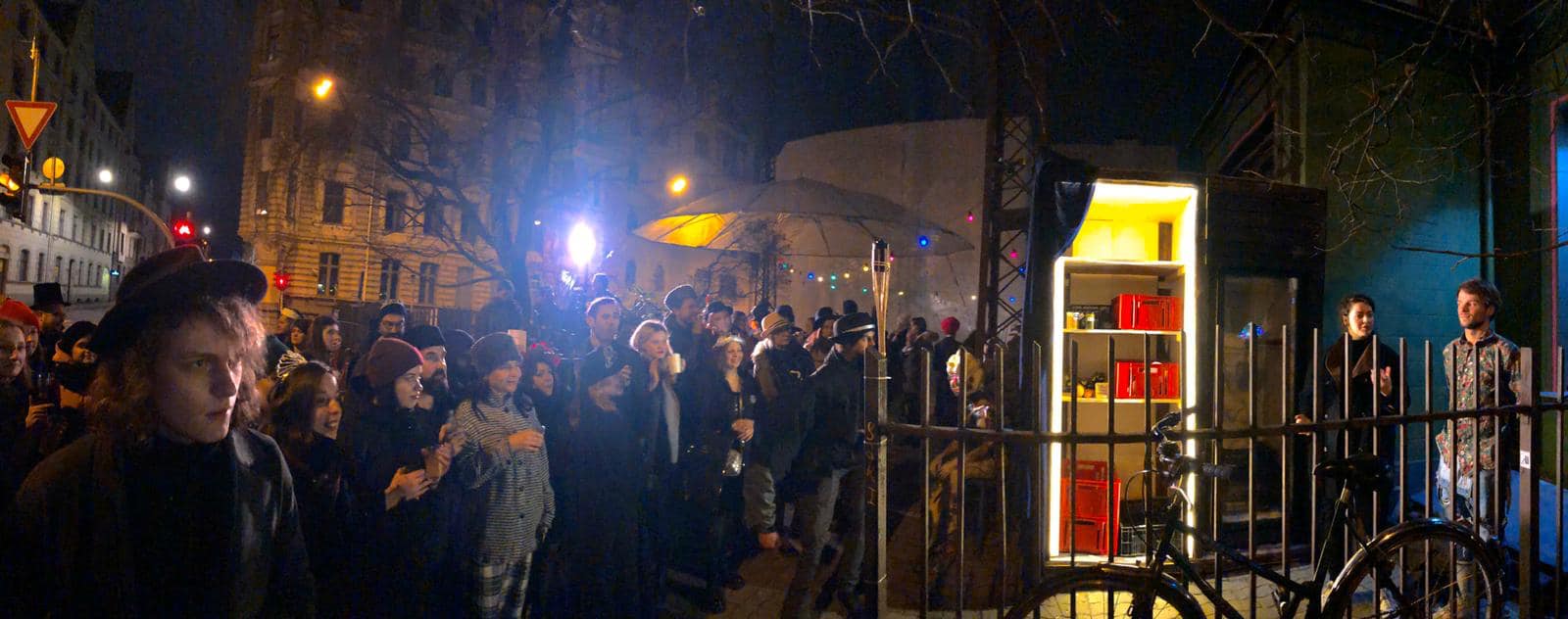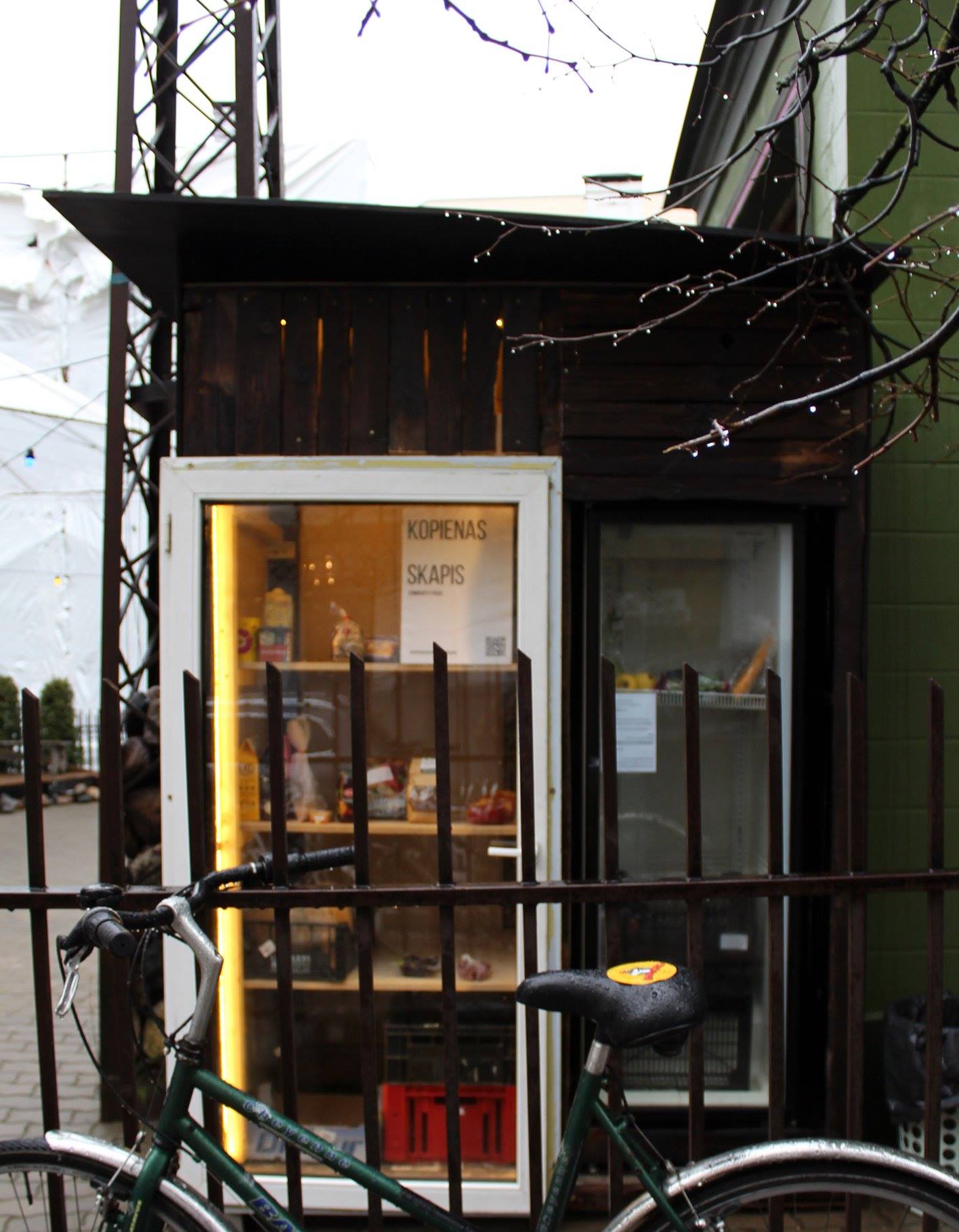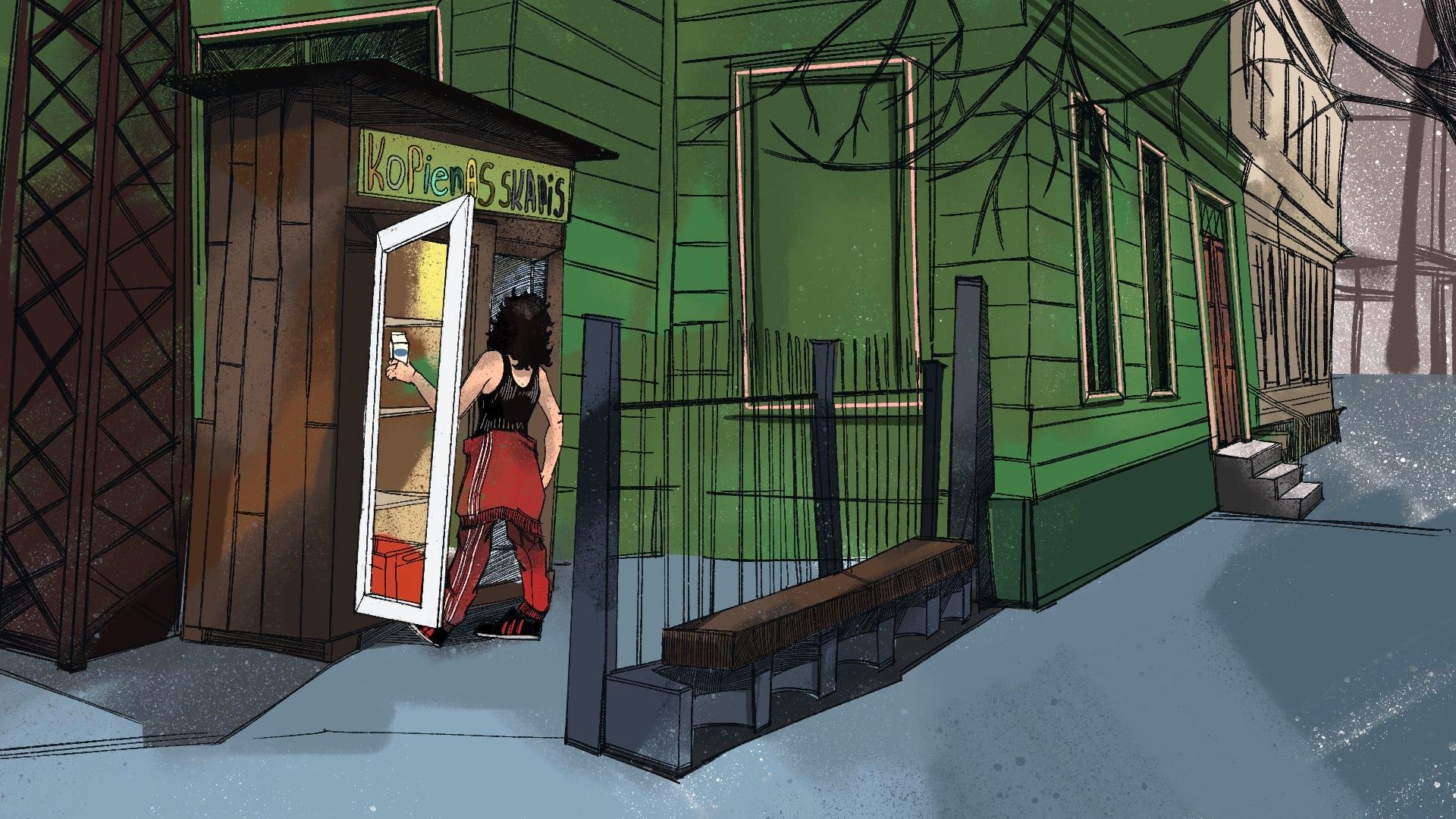Our “Community fridge” is a refrigerator in the terrace of the locally beloved contemporary culture center in Riga, Latvia – it gives opportunity to local communities, café’s and small retailers to drop off unused food items and is open for anyone to exchange or take them thus reducing food waste and food scarcity, building trust, promoting solidarity, civic activism and inclusion. It's one of the first community fridges opened in Eastern Europe and it has paved way to the opening of more.
So as the involved region could be mentioned Münster, which is the residing location of volunteer and her sending organisation, as well as the community fridges that volunteer inspired from.
The first community fridges were set up in Germany in 2012, later on also in Spain, Netherlands, UK, USA, Canada and elsewhere. However the community fridge network in Germany is well developed, in other EU countries community fridges are scarce or concept is not yet introduced.
The project "Culture exploration" (project number: 2019-2-LV02-ESC11-0) was financed with the support of European Commission’s program European Solidarity Corps and it was implemented from 1st September 2019 to 31st August 2020.
The community fridge in Riga was opened in 19th December 2019, however the Community fridge's appearance was improved over time, as well the concept, gathering of statistics, communication, institutionalization and share of knowledge was implemented most intensively until the end of project in August 2020.
Community fridge is a refrigerator in public space – it gives opportunity to local communities, restaurants and small retailers to drop off unused food items and is open for anyone to exchange or take them thus reducing food waste and food scarcity, building trust and promoting solidarity, civic activism, inclusion, belonging. The idea originated in Germany in 2012, and however is quite common in some Western Europe countries, it’s scarce in other parts of Europe and world where it’s not yet institutionalized.
Our international volunteer from Germany Beatrice Amting within EU funded project in European Solidarity Corps program took the initiative to transfer knowledge and open the community fridge in our culture center’s venue in Riga, Latvia to carefully test it under close supervision, and we were positively surprised about the high interest of society and other urban and rural communities, local Municipality, national and regional media, and National Food Surveillance Agency which resulted of:
- 7 more opened community fridges in Latvia,
- institutionalization process of community fridges and food sharing in public spaces without traceable food-chain stages of each food item (in other words - when its unknown which apple Anna put in the community fridge and which rice packet Peter) in Latvia to pave way to the opening of more public food sharing stations in Latvia and encourage with successful example communities in the Baltic region and Eastern Europe,
- as well as widely promoting sustainability, inclusion, community development and creativity.
This initiative is exemplary to other NGOs, communities, public bodies to develop and involve communities in sustainability and solidarity promotion; to open appealing, inviting food sharing stations in public inclusive places instead of social help centers, also to successfully integrate the fridge in the location, reach and involve more people, provide beautiful aesthetic experience.
Please highlight how the project can be exemplary in this context
Key objectives in terms of sustainability:
- Decreasing food scarcity and food waste – by local households, restaurants and small retailers bringing and dropping off unused, but edible food items in the fridge that otherwise may have ended up in waste (deformed, unwanted, close to expiry date) and anyone can take or exchange the food;
- Extending life-span of used materials – in creation of the community fridge food sharing station were used second hand materials – old used wood boards, bar fridge, metal and wood shelves, leftover paint and the inscription of “Kopienas skapis” (Eng. – “Community fridge”) was made from diverse previously used leftover materials – bicycle gear wheel, wooden laths, water taps, metal gate handles and other;
- Raising awareness about sustainability and involvement of society and stakeholders – by publicity in printed and digital national and regional media, as well social media, printed posters and informal talks about this successful initiative;
- Institutionalization of community fridge concept in Latvia – by consulting with National Food Surveillance Agency and discussing regulations for food sharing concept in public places without traceable food-chain stages of each food item, normalization by organizing public discussions and high media coverage, providing support for communities interested to open community fridges in their local neighborhoods.
The project can be exemplary to many communities in Latvia, Baltic region and Eastern Europe, where community fridge concept is not introduced and institutionalized yet.
Please highlight how the project can be exemplary in this context
Key objectives in terms of aesthetics and quality of experience beyond functionality:
- Use of 2nd hand materials – the old used wood plates and other used but high quality materials helped to successfully integrate the refrigerator in our hipster style interior design venue;
- Cozy hipster aesthetics – with the use of 2nd hand materials, creative craftwork and color palette we aimed to successfully integrate the community fridge in our hipster venue;
- Involvement of artists and crafts specialists – for authentic, creative appearance of community fridge and high quality outcome we involved experts and artisans of craftsmanship and woodwork;
- Neat and attractive aesthetics for diverse social group involvement – by successfully integrating the refrigerator in the public place (i.e. fridge becoming less obvious to bypassers and thus avoiding stress and fear of labeling and judgment of people taking food) and creating community fridge as a piece of art and especially in the venue of contemporary culture center with attendance of 20 000 local and foreign visitors per year (promotes involvement of diverse age and background people), it helps to involve more people into food exchange by overcoming stereotypes.
The project can be exemplary to many communities in Latvia and all around world who are willing to set up community fridge in their local area as our community fridge is not only serving as food sharing station but also functioning as artwork itself, and gives good example and inspiration for creating attractive and inviting food station to involve more people.
Please highlight how the project can be exemplary in this context
Key objectives in terms of inclusion:
- Civic activism – community fridge cannot function without the active involvement of local community (i.e. to bring/take/exchange food) thus promoting community development, leadership and civic engagement;
- Inclusion and solidarity – by opening community fridge in inclusive culture center instead of social help centers; by involving diverse background people into sharing and exchanging food items, participating in cultural or educational events related to community fridge and sustainability, promoting build of trust and feel of belonging;
- Accessibility and anonymity – community fridge is located in public space and outdoors, and local inhabitants can look into fridge, leave or take food freely without someone else being there looking over the shoulder which avoids facing someone who could potentially judge or label them as it may happen in food banks and social help centers; community fridge has long work hours and the fridge is well integrated in the interior thus making it more comfortable;
- Equal opportunities and affordability – anyone can freely bring, take or exchange the food as often and as much as wanted without limitations for free, however encouraged to be in solidarity with others – only bring edible unused food according to the community fridge rules (written on poster put on fridge doors), take what they need only to leave food for others as well.
The project can be exemplary to other NGOs, communities, municipal and other public bodies to involve society in fighting food scarcity and food waste, as well as in social inclusion and solidarity promotion; to set up food sharing stations in public inclusive places instead of specialized social help centers.
Please highlight how this approach can be exemplary
The primary reason for setting up the community fridge in our project was promoting sustainability (reducing food waste and food scarcity), however this concept cannot work without the active involvement of local communities and this create amazing opportunity to bring local communities closer, promote solidarity, inclusion and trust (by sharing and exchanging food, trust in other people by taking their brought food, not vandalizing the food sharing station, etc.). And however many of the existing community fridges in the world are set up to only function for sustainability and/or solidarity promotion, we as some other communities have also thought about creating an aesthetic, appealing and inviting food sharing station to successfully integrate the fridge in the location, reach and involve more people and provide beautiful aesthetic experience.
This project can be exemplary of how impact is greatly dependent on development and involvement of local communities and passionate volunteers, experienced and creative NGOs and venue owners to ensure creation and care of community fridge, ensure clear communication and publicity, discussions with authorities and generally success of the initiative.
Results/impacts in relation to the category applied for (Regaining a Sense of Belonging):
- Monthly our fridge on average receives 1 500 food items, involves on around 250 local inhabitants to drop-off food and around 190 local inhabitants to take food;
- Inspired and supported the opening of 7 more community fridges in urban and rural areas in Latvia;
- High national publicity and reach of society via diverse channels thus promoting solidarity, trust, food sharing and sustainability (at least 9 national and regional television stories; at least 9 printed media articles by 9 printed national and local media publishers; at least 39 digital media articles by 37 digital media publishers, blogs, homepages (34 in LV, 5 in ENG); at least 104 social media posts by not less than 31 accounts (including national and regional media, Riga Municipality Welfare department, sustainability associations and Facebook interest groups on sustainability topic); printed posters distributed in Riga neighborhoods);
- Ongoing institutionalization discussions of community fridge and food sharing concept with National Food Surveillance Services, which would make it easy for more communities to open community fridges in Latvia and would set example to communities and National Food Surveillance Services in the Baltic region and Eastern Europe;
- Ongoing discussions for cooperation with Riga Municipality due to their high interest in distributing the concept in other neighborhoods of Riga, to help Municipality help communities deliver maximum impact locally.
Please also explain the benefits that derived from their involvement.
How society was involved:
- by bringing food from home, gardens and/or workplaces (for example, after closing hours of restaurants/markets bring food that is safe for eating, but would go to waste due to deformations, expiry date next morning etc.);
- by stepping by to look or take some food from the community fridge;
- by sharing information about community fridge in social media or informal talks;
- by participating in culture or educative events related to community fridge and sustainability (workshops, lectures, discussions, soup-making), or instalation (interactive artwork for children by artist Laura Aizporiete inspired by community fridge and located next to it);
- by the high interest of printed and online media, municipalities and other stakeholders;
- by setting up more community fridges.
The benefits that derived from society involvement:
- promoted sustainability, solidarity, trust building, belonging and inclusion in general society;
- set up community fridges in other communities (in Latvia already set 7 fridges);
- success of initiative as community fridge cannot function without the involvement of society.
The global challenges addressed by local solutions:
- food scarcity – by food sharing providing food to local inhabitants;
- food waste – by food sharing avoiding edible and safe food going to waste;
- stigmatization/discrimination of marginalized groups (low income, homeless, etc.) – by food sharing instead of just food provision and in public culture place instead of social help centers, also through media society was informed that food is taken and changed by diverse social groups;
- low civic engagement – by clear message and motivation, wide media coverage, easy participation, accessible and attractive location inviting local people to become more socially active by sharing and exchanging food, promoting sustainable practices and solidarity, setting up food exchange stations in their local neighborhoods;
- climate change – due to reduction of food waste, but more importantly by promoting awareness about the need for sustainable practices and transformations, as well about importance of grassroots activism.
Innovative character compared to mainstream practices:
- Food sharing and exchange by private persons instead of municipality or government paid one-way food distributions;
- Opportunity to receive food in public popular culture/entertainment place instead of the stigmatized social help centers, food banks;
- Opportunity to share and receive food anonymously and as much as wanted without the chance of facing judgment or labeling as it may happen in social help centers due to the need to face staff distributing the food and other people waiting for the food;
- Paid attention to the visual appearance and aesthetics instead of only providing the functionality of food sharing;
- Active involvement and interaction of society, communities, grassroots NGOs, small local businesses instead of only public bodies and NGOs fighting food scarcity and food waste and promoting EU values like sustainability, active citizenship, inclusion.
Please provide clear documentation, communication of methodology and principles in this context.
Project has high potential of transferring the concept of community fridge and food sharing to communities in other Riga neighborhoods, urban and rural regions in Latvia, Baltic region, Eastern Europe and other parts of the world. Due to community fridge popularity in Western Europe but scarcity in Eastern Europe, and both region cultural, historical and socio-economical differences, this project opening community fridge in Latvia has high potential to be referred to as an example and inspiration for opening more community fridges, developing other food sharing or grassroots initiatives in Eastern Europe.
This far we have shared project results with the help of national and regional media, posters, social media in our social channels, as well as local Facebook groups related to sustainability and food sharing. We have consulted, transferred knowledge and methodology in detail to people who reached out to us and were interested to open community fridges in their local communities, however we have not yet created and published an info-pack of methodology and suggestions for opening community fridge due to multiple reasons (low work capacity, need for continuing discussions with National Food Surveillance Services for clear documentation and regulations, need for additional financial support). The grant would allow to involve experts to further develop the project – continue institutionalization by discussions with National Food Surveillance Services, create network of communities who have opened and are willing to open food sharing stations in their local neighborhoods, continue discussions with Municipality of Riga for future cooperation as well reach out to other municipalities, small and big businesses and potential partners, provide informative materials, info-packs and necessary support, share knowledge and experience locally and internationally to promote the concept and fight food scarcity, food waste and increase solidarity together.






@Kaņepes culture center (Association "Kaņepes laikmetīgās kultūras centrs"), 2020
Content licensed to the European Union.